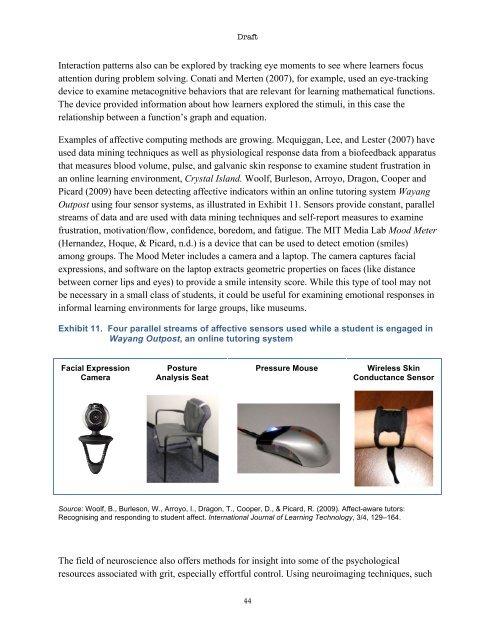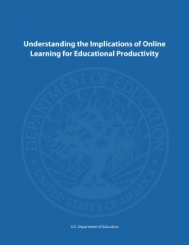Promoting Grit, Tenacity, and Perseverance - U.S. Department of ...
Promoting Grit, Tenacity, and Perseverance - U.S. Department of ...
Promoting Grit, Tenacity, and Perseverance - U.S. Department of ...
Create successful ePaper yourself
Turn your PDF publications into a flip-book with our unique Google optimized e-Paper software.
Draft<br />
Interaction patterns also can be explored by tracking eye moments to see where learners focus<br />
attention during problem solving. Conati <strong>and</strong> Merten (2007), for example, used an eye-tracking<br />
device to examine metacognitive behaviors that are relevant for learning mathematical functions.<br />
The device provided information about how learners explored the stimuli, in this case the<br />
relationship between a function’s graph <strong>and</strong> equation.<br />
Examples <strong>of</strong> affective computing methods are growing. Mcquiggan, Lee, <strong>and</strong> Lester (2007) have<br />
used data mining techniques as well as physiological response data from a bi<strong>of</strong>eedback apparatus<br />
that measures blood volume, pulse, <strong>and</strong> galvanic skin response to examine student frustration in<br />
an online learning environment, Crystal Isl<strong>and</strong>. Woolf, Burleson, Arroyo, Dragon, Cooper <strong>and</strong><br />
Picard (2009) have been detecting affective indicators within an online tutoring system Wayang<br />
Outpost using four sensor systems, as illustrated in Exhibit 11. Sensors provide constant, parallel<br />
streams <strong>of</strong> data <strong>and</strong> are used with data mining techniques <strong>and</strong> self-report measures to examine<br />
frustration, motivation/flow, confidence, boredom, <strong>and</strong> fatigue. The MIT Media Lab Mood Meter<br />
(Hern<strong>and</strong>ez, Hoque, & Picard, n.d.) is a device that can be used to detect emotion (smiles)<br />
among groups. The Mood Meter includes a camera <strong>and</strong> a laptop. The camera captures facial<br />
expressions, <strong>and</strong> s<strong>of</strong>tware on the laptop extracts geometric properties on faces (like distance<br />
between corner lips <strong>and</strong> eyes) to provide a smile intensity score. While this type <strong>of</strong> tool may not<br />
be necessary in a small class <strong>of</strong> students, it could be useful for examining emotional responses in<br />
informal learning environments for large groups, like museums.<br />
Exhibit 11. Four parallel streams <strong>of</strong> affective sensors used while a student is engaged in<br />
Wayang Outpost, an online tutoring system<br />
Facial Expression<br />
Camera<br />
Posture<br />
Analysis Seat<br />
Pressure Mouse<br />
Wireless Skin<br />
Conductance Sensor<br />
Source: Woolf, B., Burleson, W., Arroyo, I., Dragon, T., Cooper, D., & Picard, R. (2009). Affect-aware tutors:<br />
Recognising <strong>and</strong> responding to student affect. International Journal <strong>of</strong> Learning Technology, 3/4, 129–164.<br />
The field <strong>of</strong> neuroscience also <strong>of</strong>fers methods for insight into some <strong>of</strong> the psychological<br />
resources associated with grit, especially effortful control. Using neuroimaging techniques, such<br />
44
















